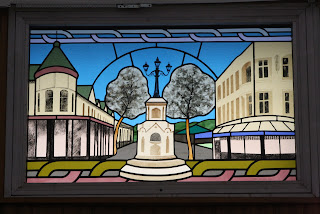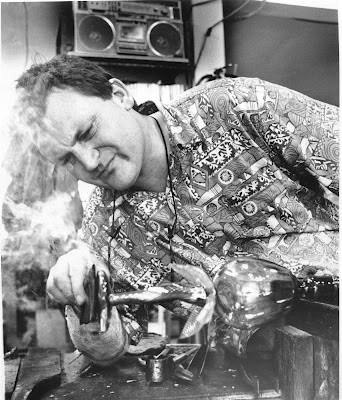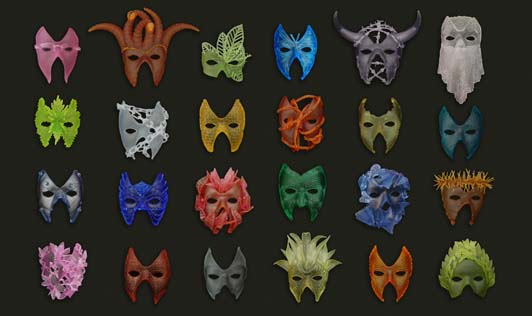One trap when you try to
write a short history of something is that you leave somebody out. When I wrote
my essay The beginnings of New Zealand glass in New Zealand Glass Art (Bateman 2010), I made just that mistake. I tried to describe all the glass studios that were in existence in the
1970s and 1980s, but sadly I left out a small but important example, Avalon Glass
which was set up in 1985 near Fox River on the West Coast of the South Island.
Although I didn’t know a great deal about it, I was aware of it and
I should have included it - I simply overlooked it. I must apologise to all those
involved, especially Greg Smith who had told me about it.
This small bowl, a recent TradeMe purchase, is signed G Smith 88
But I know a lot more about
Avalon Glass now, because, through the kindness of Evelyn Dunstan, I have been
able to read the remarkably frank and revealing paper that Greg Smith gave on the history of Avalon
Glass at the 2003 conference of the Glass Art Society in Seattle, USA. Entitled
“The Blood, the Drugs and the Fear: The Founding of Avalon Glass”, it has been
helpful in providing background to the history of Avalon that follows.

Bowl above signed G.Smith 90, vase at right signed G.Smith Te Miko 1990
Avalon Glass was
set up by a group of people with no experience of glassmaking in a place that
had no electricity and had no fuel for making glass. In 1985 a group of hippies at
the Fox River commune decided, for whatever reason, to set up a glass studio. In
order to provide enough light to be able to see, a small creek in the hills behind
the commune was dammed. A pipe from the dam brought water, and sometimes mud
and all sorts of other things, down the hillside to drive a Pelton wheel
connected to an inverter and a bank of truck batteries. Greg says there was
sufficient power for two dim lights.
The closest source of gas
was a supplier of bottled LPG 300 miles away. The distance and the cost
suggested they make their own gas. They bought a wood gasifier from
Auckland. Although the local timber mills could provide a ready supply of fuel,
the wood had to be trucked 30 miles, it had to be cut into small enough pieces for
the gasifier, and because of the climate it was often much too wet to burn. Eventually,
after a lot of effort and going through a large number of chainsaws, they
managed to produce a very variable supply of gas. Building a furnace was the
next task, one which fell to Greg’s lot, and not one in
This paperweight is signed R.Reedy 1994 NZ
which he experienced
immediate success. When it was finished they needed glass. They spent days at
the local rubbish dump collecting bottles which they took back to Avalon to
wash, break up and throw into the furnace. The avid drinking habits of much of
the local population also provided a source of bottles, in exchange for
supplies of coffee or cannabis.
Greg summarises all of this
by saying “So there we were, a full-fledged alternative glassblowing studio
perched on the side of an unstable cliff overlooking the sea, and we were the
source of heat and light for a community of hippies, eccentrics, and burn-outs.
There was always someone hanging out in the kitchen, coffee in the pot, pot on
the table, and wild stories and reminiscences being recounted”.
In spite of what might seem
an unpromising setting, good pieces were produced at Avalon, of which there are
a few examples here. The quality of the glass is often very good, with no
bubbles or inclusions.
One of Greg Smith's 'anemone' series, this piece is signed 'G.Smith Te Miko 96'
I’ve not seen the name ‘Avalon’
on any glass, though I haven’t seen very much glass from there. In 1990 Greg Smith set up Te Miko Glass with Carolyn Hewlett, Te Miko being the name of the locality. At least some of that glass is marked Te Miko, like the anemone
bottle shown here, marked Te Miko 96. Commenting on a photograph of it,
Greg Smith confirmed he made it. “It was one of our anemone series and in
fact one of the last of that period as from 95 on we no longer worked at Avalon
and Ross Smith and Lynda Braid changed its name to Seal Island.” After the first version of this blog appeared, Greg Smith offered me a few corrections (which I have made) and told me that "Ross Smith and Lynda Braid set up Seal island Studios after Ross called time on Avalon Glass, as he owned the building and was the only commune member - the rest of us were locals living elsewhere."
Greg also said he set up Te
Miko in 1995 with his then wife Carolyn Hewlett. “As well as blown glass work
we made glass jewellery. Carolyn worked as my hot glass assistant. We
disbanded Te Miko in 1999.” However, the piece signed G.Smith Te Miko 1990,
shows the name was being used before 1995.
In about 1993 Ross Smith
owned the studio and leased it to Greg Smith and Robert Reedy who were making
glass there.
Lynda Braid joined Avalon in 1993, and then in 1996
with her partner Ross Smith set up Seal Island Studio, named for Seal Island off the
coast a few kilometres north of Te Miko.
Ross Smith, with Greg Smith, had been one of the founders of Avalon.
There is no doubt a great deal more to be told
about Avalon Glass, its creation and its operation. What I have tried to do here
is correct its unfortunate omission from New Zealand Glass Art and perhaps
stimulate those involved to tell their own stories.






























